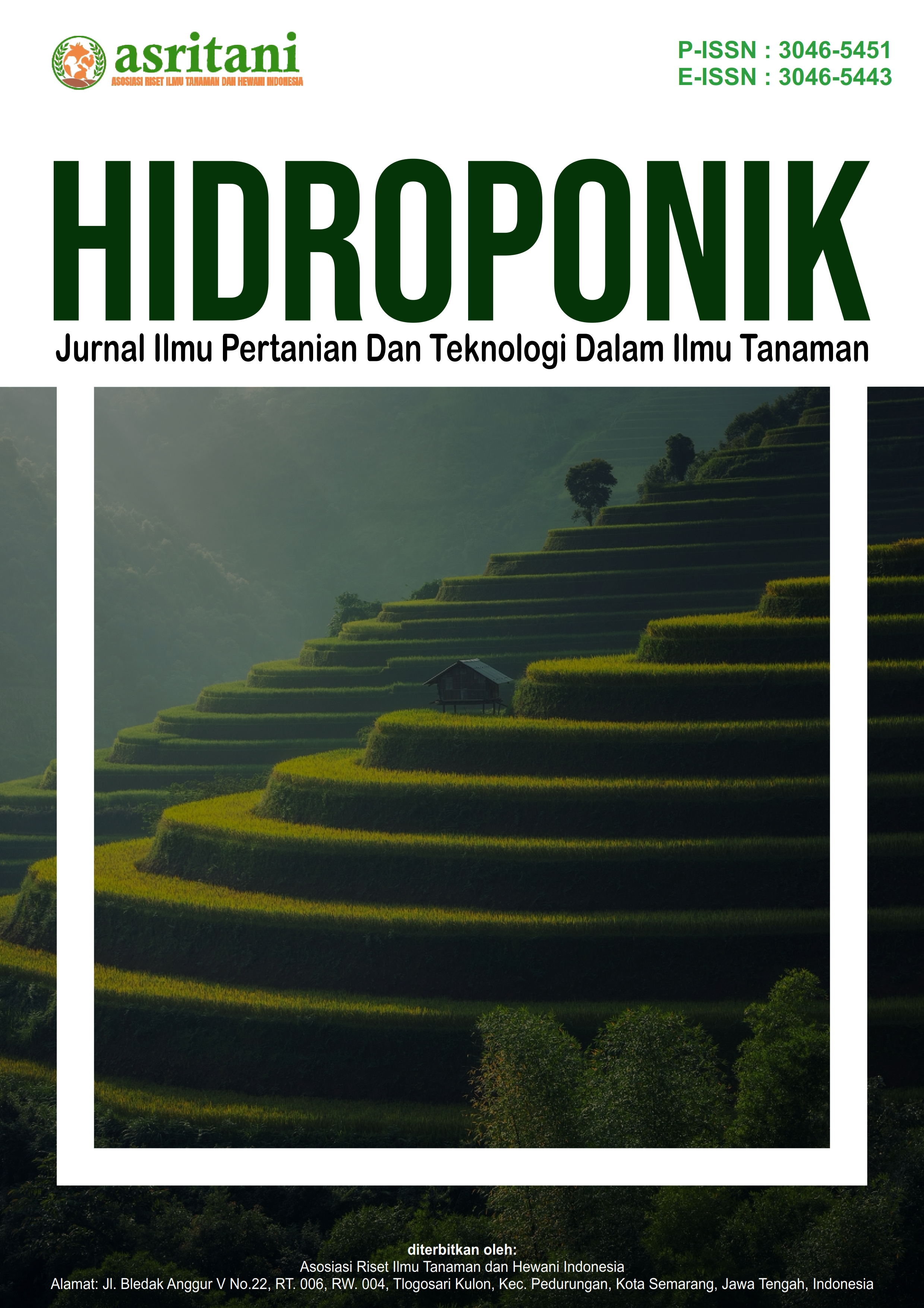Peranan Bakteri Bacillus sp. sebagai Agen Biofertilizer dalam Meningkatkan Kesuburan Tanah dan Produktivitas Tanaman : Kajian Literatur
DOI:
https://doi.org/10.62951/hidroponik.v2i1.227Keywords:
Bacillus sp., Biofertilizer, Soil fertilityAbstract
The use of fertilizer in plant cultivation is basically carried out to meet the availability of nutrients for plants in order to obtain optimal results. However, excessive use of fertilizer can actually have a negative impact on the ecosystem, such as environmental pollution and decreasing soil quality. The use of biofertilizer as a substitute for biological fertilizer is an alternative that can be used to reduce dependence on chemical fertilizers. Biofertilizer is a biological fertilizer containing various live microorganisms which is used to increase plant productivity by improving the quality of soil fertility. One of the microbes that acts as a biofertilizer is the Bacillus sp. The purpose of this article is to find out how Bacillus sp. functions as a biological fertilizer that can increase soil fertility and increase crop productivity. Bacillus is a genus of bacteria that can be used as a biofertilizer because of its more varied antagonistic mechanisms and ability to produce endospores. The method used in this article is a meta-analysis or literature review method in several journals published online which are integrated with Google Scholar.
References
Benu, F. L., Lawa, Y., & Neolaka, Y. A. B. (2023). Peran biofertilizer pada pertanian lahan kering. Jurnal Beta Kimia, 3, 40–49.
Guntur Trimulyono, Mukamto, Ulfah, S., Mahalina, W., Syauqi, A., & Istiqfaroh, L. (2015). Isolasi dan karakterisasi Bacillus sp. pelarut fosfat dari rhizosfer tanaman leguminosae. Sains Dan Matematika, 3(2), 62–68.
Hidayat, I. (2004). Screening aktivitas enzim Bacillus sp. yang diisolasi dari Taman Nasional Gunung Halimun. Berita Biologi, 7(1), 25–32.
Kalay, A. M., Kesaulya, H., & Talahaturuson, A. (2020). Aplikasi pupuk hayati konsorsium strain Bacillus sp. dengan berbagai konsentrasi dan cara pemberian terhadap pertumbuhan bibit pala (Myristica fragrans Houtt). Jurnal Pertanian, 2(1), 45–59.
Kusuma, H., & Royanti Vidia, C. N. E. (2023). Indeks keanekaragaman bakteri Bacillus sp. dari tanah kebun raya Liwa. Jurnal Ilmu Tanah, 18, 46–52.
Muslimah, S. A., & Masnilah, R. (2024). Kajian efektivitas Bacillus sp. dengan penambahan pupuk kompos dalam mengendalikan busuk hitam (Xanthomonas campestris) pada tanaman kubis bunga. Berkala Ilmiah Pertanian, 7(1), 41. https://doi.org/10.19184/bip.v7i1.38168
Pangestu, R. W., Kusbianto, D. E., Perkebunan, P. S., Pertanian, F., Jember, U., Agroteknologi, P. S., Pertanian, F., & Jember, U. (2022). Aplikasi pupuk hayati (biofertilizer) dan pupuk ZA terhadap pertumbuhan dan hasil tanaman buncis (Phaseolus vulgaris L.). Jurnal Pertanian, 2, 10–19.
Romadloni, M. Y., Wibowo, F. A. C., Wahidiah, T., & Pradipta, A. (2024). Isolasi bakteri pelarut fosfat (Bpf) pada hutan produksi di kawasan hutan dengan tujuan khusus (KHDTK) Pujon Hill Umm, Kabupaten Malang. Berita Biologi, 23(1), 91–102. https://doi.org/10.55981/beritabiologi.2024.4148
Saikia, S. P., & Jain, V. (n.d.). Biological nitrogen fixation with non-legumes: An achievable target or a dogma? Journal of Agricultural Research, 15, 317–322.
Setiaji, A., Annisa, R. R. R., & Rahmandhias, D. T. (2023). Bakteri Bacillus sebagai agen kontrol hayati dan biostimulan tanaman. Rekayasa, 16(1), 96–106. https://doi.org/10.21107/rekayasa.v16i1.17207
Subowo, Purwani, J., & Rochayati, S. (2013). Prospek dan tantangan pengembangan biofertilizer untuk perbaikan kesuburan tanah. Jurnal Sumberdaya Lahan, 7(1), 15–26.
Sudiarti, D. (2017). The effectiveness of biofertilizer on plant growth soybean “edamame” (Glycin max). Jurnal Pertanian, 1(2), 97–106.
Trisilawati. (2017). Pemanfaatan pupuk hayati (biofertilizer) pada tanaman rempah dan obat. Perspektif, 16(1), 33–43.
Wulandari, N., Irfan, M., & Saragih, R. (2020). Isolasi dan karakterisasi plant growth promoting rhizobacteria dari rizosfer kebun karet rakyat. Dinamika Pertanian, 35(3), 57–64. https://doi.org/10.25299/dp.2019.vol35(3).4565
Downloads
Published
How to Cite
Issue
Section
License
Copyright (c) 2025 Hidroponik : Jurnal Ilmu Pertanian Dan Teknologi Dalam Ilmu Tanaman

This work is licensed under a Creative Commons Attribution-ShareAlike 4.0 International License.





